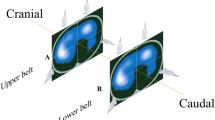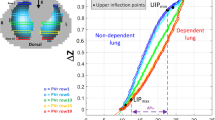Abstract
Objective
To evaluate the ability of internal thoracic impedance (ITI) monitors to predict cardiogenic pulmonary edema in patients at risk.
Design and Setting
Prospective, controlled multicenter study.
Patients
We examined 328 consecutive patients admitted for cardiac conditions. Of these 265 patients aged 27–83 years with no clinical signs of pulmonary edema, extracardiac respiratory failure or pacemakers comprised the study cohort.
Intervention
Monitoring of the lung's electrical impedance was used for predicting cardiogenic pulmonary edema since accumulation of blood and fluid decreases impedance values.
Measurements and results
Impedance of the lung is the main feature of ITI measured by the RS-207 monitor: decreased ITI prior to the clinical signs of cardiogenic pulmonary edema was used as the prediction criterion. The clinical signs used for confirmation of its prediction were dyspnea, cyanosis, pulmonary rales, crepitations, arterial hypoxemia, and radiographic evidence of pulmonary congestion in chest radiographs. Clinicians were blinded to the results of ITI measurements and radiologists were blinded to both ITI and clinical data. Thirty-seven patients developed cardiogenic pulmonary edema while being monitored. ITI decreased by more than 12% of baseline in all of them; this occurred at 30 min or longer (26 patients) and at 60 min or longer (11 patients) before the appearance of clinical signs. ITI fell by less then 10.1% of baseline in all 228 patients who did not develop the edema.
Conclusion
Monitoring ITI is suitable for early prediction of cardiogenic pulmonary edema, before the appearance of the clinical signs.




Similar content being viewed by others
References
Fein A, Grossman RF, Jones G, Goodman PC, Murray JF (1979) Evaluation of transthoracic electrical impedance in the diagnosis of pulmonary edema. Circulation 60:1156–1160
Saunders CE (1988) The use of transthoracic electrical bioimpedance in assessing thoracic fluid status in emergency department patients. Am J Emerg Med 6:337–340
Spinale FG, Reines HD, Cook MC, Crawford FA (1989) Noninvasive estimation of extra vascular lung water. J Surg Res 47:535–540
Campbell JH, Harris ND, Zhang F, Morice AH, Brown BH (1994) Prediction of changes in intrathoracic fluid in man using electrical impedance tomography. Clin Sci (Lond) 87:97–101
Newell JC, Edis PM, Ren X, Larson-Wiseman JL, Danyleiko MD (1996) Assessment of acute pulmonary edema in dogs by electrical impedance imaging. IEEE Trans Biomed Eng 43:133–138
Nierman DM, Eisen DI, Fein ED, Hannon E, Mechanick JI, Benjamin E (1996) Transthoracic bioimpedance can measure extra vascular lung water in acute lung injury. J Surg Res 65:101–108
Kubicek WG, Patterson RP, Witsoe DA (1970) Impedance cardiography as a noninvasive method of monitoring cardiac function and other parameters of the cardiovascular system. Ann NY Acad Sci 170:724–731
Staub NC, Hogg JC (1980) Conference report of a workshop on the measurement of lung water. Crit Care Med 8:752–759
Miniati M, Pistolesi M, Milne EN, Giuntini C (1987) Detection of lung edema. Crit Care Med 15:1146–1155
Yamamoto T, Yamamoto Y (1976) Electrical properties of the epidermal stratum corneum. Med Biol Eng 14:151–158
Yamamoto Y, Yamamoto T (1986) Characteristics of skin admittance for dry electrodes and measurement of skin moisture. Med Biol Eng Comput 24:71–77
Itoh M (1981) Apparatus for measuring a pulmonary function. United States patent no 4:269:195
Yu C-M, Wang L, Chau E, Hon-Wah Chan R, Kong S-L, Tang M-O, Christensen J, Stadler R, Lau C-P (2005) Intrathoracic impedance monitoring in patients with heart failure. Circulation 112:841–848
Rabinovich P, Shochat M, Zeldin V, Milman O (1998) Method and device for stable impedance plethysmography. United States patent no 5:749:369
Charach G, Rabinovich P, Grosskopf I, Weintraub M (2001) Transthoracic monitoring of the impedance of the right lung in patients with cardiogenic pulmonary edema. Crit Care Med 29:1137–1144
Shochat M, Meisel S, Rabinovich P, Peled B (2003) Monitoring of the internal thoracic impedance: a novel method to detect pulmonary edema before appearance of clinical signs. J Am Coll Cardiol Suppl, 52nd Annual Scientific Session, pp 1206–1273
Shochat M, Meisel S, Rabinovich P, Peled B, Shotan A (2004) A new method for detecting cardiogenic pulmonary edema before appearance of clinical signs and for the evaluation of treatment efficacy. J Am Coll Cardiol Suppl, 53nd Annual Scientific Session, pp 1154–1196
Shochat M, Charach G, Frimerman A, Rabinovich P, Shotan A, Meisel S (2004) Internal thoracic impedance monitoring: a new prospect in acute heart failure. The 51th Annual Conference of the Israel Heart Society together with the Israel Society of Cardiothoracic Surgery, p 65
Shochat M, Charach G, Frimerman A, Rabinovich P, Shotan A, Meisel S (2004) Internal thoracic impedance monitoring: a new prospect in acute heart failure (abstract). Eur Heart J 25:[Suppl 72]:500
Shochat M, Kazatzker M, Charax G, Frimerman A, Rabinovich P, Shotan A, Meisel S (2005) Internal thoracic impedance monitoring: a new tool for the early diagnosis and treatment of acute heart failure (abstract). Eur J Heart Fail 4 [Suppl 1] 354:79–80
Braumwald E, Colcci S, Grossman W (1997) Clinical aspects of heart failure. High output heart failure. In: Braumwald E (ed) Heart diseases, vol 1, 6th edn. Saunders, New York, p 177
Massie BM, Amidon TM (1998) Acute pulmonary edema: essentials of diagnosis. In: Tierney LM, McPhee SJ, Stephen J (eds) Current medical diagnosis and treatment, 37th edn. Lange, London, p 412
Cropper MA, Wiener-Kronish JP, Hashimoto S (1994) Acute cardiogenic pulmonary edema. Clin Chest Med 15:501–515
Mantle JA, Russell RO Jr, Moraski RE, Rackley CE (1976) Isosorbide dinitrate for the relief of severe heart failure after myocardial infarction. Am J Cardiol 37:263–268
Daskalov TR (1989) A comparison of the haemodynamic effect of isosorbide-5-mononitrate and isosorbide dinitrate administered in intravenous injection to patients with acute myocardial infarction. Cor Vasa 31:376–386
Szwarc G, Lellouche D, Usdin JP (1982) Use of isosorbide dinitrate (Risordan) injection in left ventricular failure following acute myocardial infarction. Nouv Presse Med 11:2079–2082
Verma SP, Silke B, Hussain MG, Reynolds GW, Richmond A, Taylor SH (1987) First-line treatment of left ventricular failure complicating acute myocardial infarction: a randomized evaluation of immediate effects of diuretic, venodilator, arteriodilator, and positive inotropic drugs on left ventricular function. J Cardiovasc Pharmacol 1:38–46
Kuboki K, Sakai M, Kuwajiama I, Maeda S, Ohkawa S, Ueda K, Kuramoto K (1992) Acute hemodynamic effects of intravenous bolus injection of isosorbide dinitrate in aged patients with congestive heart failure. Nippon Ronen Igakkai Zasshi 29:390–395
Larsen RJ, Marx ML (2001) An introduction to mathematical statistics and its applications, 3rd edn. Prentice Hall
Itoh M, Takahashi K, Nishida H, Sakagami K, Okubo T (1996) Estimation of the optimal cut off point in a new immunological faecal occult blood test in a corporate colorectal screening programmer. J Med Screen 3:66–71
Acknowledgements
We are grateful to Dr. Alexander M. Samarov for help in statistical analysis. Esther Eshkol is thanked for manuscript preparation.
Author information
Authors and Affiliations
Corresponding author
Rights and permissions
About this article
Cite this article
Shochat, M., Charach, G., Meyler, S. et al. Prediction of cardiogenic pulmonary edema onset by monitoring right lung impedance. Intensive Care Med 32, 1214–1221 (2006). https://doi.org/10.1007/s00134-006-0237-z
Received:
Accepted:
Published:
Issue Date:
DOI: https://doi.org/10.1007/s00134-006-0237-z




